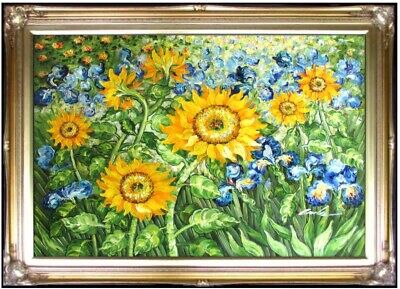
“Van Gogh’s ‘Irises’ Were Originally Intended to Be a Different Color”

### Unveiling Van Gogh’s “Irises”: The Journey to Discover the Real Color of the Famous Flowers
Art has always had an enigmatic quality, capable of both inspiring awe and sustaining deep mysteries. One such mystery, concerning the colors of Vincent van Gogh’s renowned painting “Irises” (1889), appears to be finally solved by a team of conservators and chemists at the Getty Center in Los Angeles. Their research indicates that the flowers in this iconic work were never meant to be blue—but rather a light, vivid violet.
Van Gogh’s “Irises” is widely celebrated for its vibrant use of color and its emotional resonance, reflecting his state of mind while confined in a psychiatric hospital in Saint-Rémy-de-Provence in France. At the time of its creation, the painter was grappling with severe mental health issues, including depression, hallucinations, and possible psychosis. This turbulent period, however, proved to be artistically prolific for Van Gogh, producing over 150 paintings within the year he spent at the institution. Among these was “Irises,” a work capturing the delicate blossoms from the hospital’s garden—a quiet place of solace during his emotional storm.
### The Mystery of the Blue “Irises”
Much has been written about “Irises,” both in terms of its record-breaking $53.9 million sale at Sotheby’s in 1987 and its significance in Van Gogh’s body of work. Still, one enduring question remained: Was the blue color of the irises intentional, or a result of time’s wear on the painting materials?
This inquiry set conservationists, including Getty Museum Associate Paintings Conservator Devi Ormond and Getty Conservation Institute Research Chemist Catherine Patterson, on a years-long mission aimed at finally answering it. Their investigation resulted in a groundbreaking discovery: The flowers Van Gogh painted were, in fact, violet, not blue.
Their curiosity was first piqued by a letter Van Gogh sent to his brother Theo, in which the artist described painting “violet flowers.” Despite having known about this letter for years, the scientific community had never undertaken exhaustive research to confirm Van Gogh’s description. That changed when the Getty team seized an opportunity presented by the pandemic, during which the museum closed its doors to the public. Free from external demands, Patterson and Ormond rotated the painting out of exhibition and embarked on a sophisticated technical analysis.
### The Science Behind Van Gogh’s Changing Palette
The crux of the investigation rested on identifying the chemical composition of the pigments Van Gogh used. The team discovered that Van Gogh’s original violet hue was created by mixing blue paint with a red pigment known as “Geranium Lake.” This particular red pigment, however, is highly sensitive to light and slowly breaks down over time. Crucially, the chemical structure of Geranium Lake fades under prolonged exposure to light, degrading the red tones and shifting the painting’s irises toward a blue appearance.
By analyzing the painting using macro X-ray fluorescence (MAXRF) technology—an advanced, non-invasive method for studying chemical elements in paint—the researchers were able to detect traces of bromine. Bromine had remained in the painting, a ghostly marker of the red that had once dominated the flowers. Identifying bromine provided the final piece of the puzzle: The irises were originally violet, not blue.
Ormond explained that the gradual fading of the red component of the pigment resulted in today’s familiar blue irises, but this shade was never what Van Gogh envisioned.
### A Digital Revelation: Restoring Van Gogh’s Vision
To bring Van Gogh’s intended vision back to life, the team utilized digital color reconstruction techniques. This allowed them to recreate—and display—the original color scheme, showing the painting as the artist would have perceived it over a century ago. Upon reflection, this restoration aligns perfectly with Van Gogh’s fascination with color theory. In many of his compositions, Van Gogh intentionally paired complementary colors to enhance a sense of contrast and vibrancy. In the case of “Irises,” the purple flowers set against the green backdrop would have created a bolder, more dynamic visual harmony. Blue and green, being neighbors on the color wheel, would not have created the same intensity of contrast.
At the Getty Center, a new exhibit titled *Ultra-Violet: New Light on Van Gogh’s Irises* highlights the research, showcasing a digital reconstruction alongside the original painting. The exhibition offers visitors the chance to reimagine “Irises” as Van Gogh initially conceived it, allowing them to experience the painting’s original depth. Many gallery visitors have remarked how the restored violet irises make the painting feel more three-dimensional, turning a flat depiction of flowers into a vivid patch bursting with life.
Beyond their scientific achievement, Ormond and Patterson reflected on the deep emotional and historical significance of their discovery. Not only did they solve a century-old puzzle, but they also unearthed an early case of art therapy—an essential device in Van Gogh’s